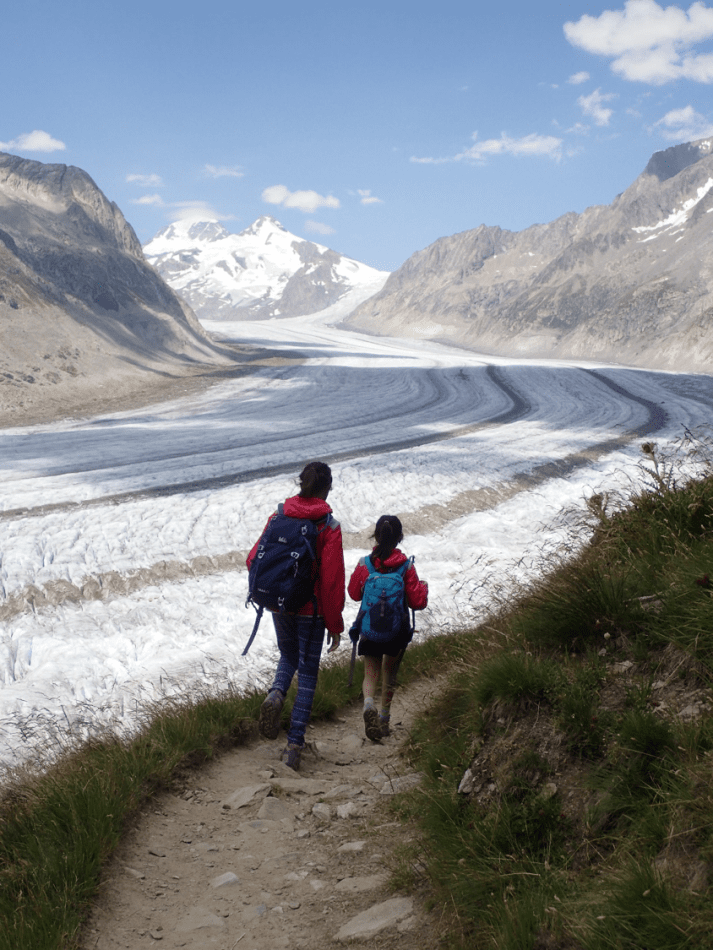Jul 25 2019
The key reasons for decade-scale climate variations have been identified by a new reconstruction of global average surface temperature variation over the last 200 decades.
 Global climate change threatens the continued existence of glaciers, such as the Aletsch Glacier in Switzerland, photographed in July 2015. Image credit: Anupma Gupta/Michael Evans (Click image to download hi-res version.)
Global climate change threatens the continued existence of glaciers, such as the Aletsch Glacier in Switzerland, photographed in July 2015. Image credit: Anupma Gupta/Michael Evans (Click image to download hi-res version.)
The analysis proposes that the present warming rate of the Earth, due to human greenhouse gas emissions, is higher when compared to any warming rate noticed earlier. In addition, the scientists found that airborne particles from volcanic eruptions were mainly responsible for many short episodes of global cooling before the Industrial Revolution of the mid-19th century.
Moreover, the new temperature reconstruction mostly conforms to climate model simulations of the same time period. The scientists discovered that it also conforms to temperature variations due to identifiable factors, like greenhouse gases and volcanic aerosols, as well as to random changes in climate that occur on the same timescales.
This implies that the present climate models precisely denote the contributions of different influences on global climate change—and can accurately predict future climate warming.
The group of scientists—19 members of the Past Global Changes (PAGES) project, including the University of Maryland Geology Professor Michael Evans—employed seven different statistical techniques to carry out the reconstruction. The outcomes have been reported online on July 24th, 2019, in the journal Nature Geoscience.
Our reconstructions look like the ‘hockey stick’ diagram of global temperature change that was first reconstructed more than two decades ago. Thanks to the work of the PAGES community, we have much more data now. The results were consistent regardless of how we created the reconstructions or which randomly chosen subset of input data we used.
Professor Michael Evans, Co-Chair, PAGES, University of Maryland
Evans has a joint appointment at UMD’s Earth System Science Interdisciplinary Center (ESSIC).
The new 2,000-year reconstruction uses the most comprehensive and detailed database of its type compiled so far to improve on earlier efforts.
This dataset, meticulously assembled by PAGES scientists, comprises approximately 700 separate publicly available records from sources that consist of indicators of past temperatures, for example, long-lived trees, marine and lake sediments, ice cores, and reef-building corals. The data are obtained from every part of Earth’s continental areas and main ocean basins.
The PAGES research group was able to find out the relative contributions of a number of influences on global temperatures in due course by comparing the new reconstructions with current climate simulations created using the Coupled Model Intercomparison Project 5 (CMIP5) climate models.
These involved natural influences, like variations in solar heating and the cooling effect of particles thrown out by volcanic eruptions, and also the human-caused influence of greenhouse gas emissions.
The outcomes imply that volcanic activity was accountable for changes prior to around 1850. After that, greenhouse gases turned out to be the principal influence on global climate. By eliminating these influences in their analysis, the scientists also determined the magnitude of the random fluctuations that cannot be traced to a particular cause. The research group’s data-based reconstructions also conformed to model simulations when assessing these random variations.
Evans added, “This makes us more confident that our reconstructions are realistic and, in turn, that the climate models are simulating past and future climate warming faithfully.”
This conformity between the research team’s data-based reconstructions and the CMIP5 simulations implies that current climate models can precisely predict future global temperature variation over the next few years, according to Evans. However, these simulations rely greatly on the preferences that humans make in the future, which are extremely difficult to predict, added Evans.
The uncertainty in the influence of human activities is not so large when looking forward only a few decades. But in the longer term, the choices we make for our energy sources and how much carbon these sources emit really matter.
Professor Michael Evans, Co-Chair, PAGES, University of Maryland
This research was supported by the National Science Foundation, the Swiss Academy of Sciences, the Swiss National Science Foundation (Award No. PZ00P2_154802), the German Research Foundation (Award No. RE3994-2/1), the European Union (Award No. 787574), the National Natural Science Foundation of China (Award Nos. 41877440, 41430531, and 41690114), and the UK Natural Environment Research Council (Award No. NE/P006752/1).